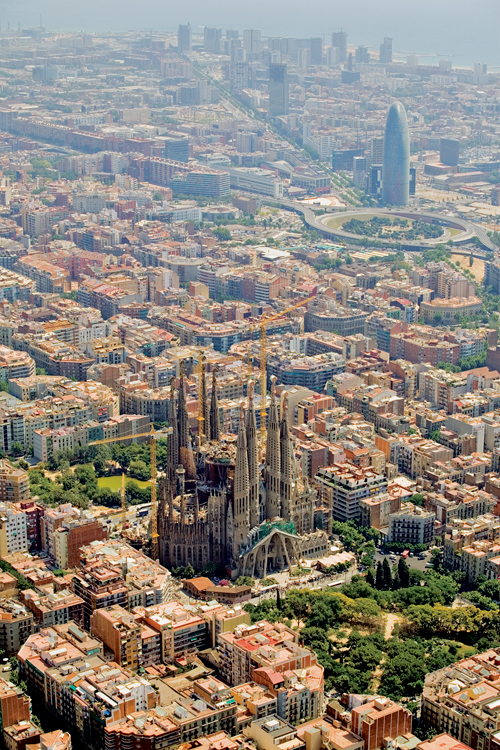An End in Sight for a Centuries-Old Building Project?
Learning Objectives:
- Describe how Gaudí earlier architectural projects influenced his design for the Sagrada Família church.
- Become familiar with the unique design of the Sagrada Família church, and church architecture in general, including specific terminology for various spaces.
- Describe recent technological advances—in both design and construction—that have expedited building progress on the Sagrada Família.
- Describe the different tools used by current builders of the Sagrada Família to carry out Gaudí's vision for the building.
Credits:
Chartres Cathedral's imposing spires, rising heroically above the wheat fields in the countryside southwest of Paris, are a testament to the interminable construction that went into Medieval churches. While the shorter spire was begun in the 12th century, its taller, more flamboyant neighbor was not completed until some 400 years later. The campaniles of Barcelona's Sagrada FamÃlia (Holy Family) church are equally impressive, and along with the cranes that hover above them, represent the most visible elements of an unmissable construction site in the center of a bustling metropolis-a unique, modern-day example of a complex building more than 125 years in the making.
Unlike Romanesque and Gothic cathedrals, in which the master builder remains largely unknown, the Sagrada FamÃlia is the vision of one very well-known architect-the eccentric Catalan Antoni GaudÃ, whose Modernista buildings created a sensation in fin-de-siècle Barcelona. But much like Chartres, which battled destructive fires on numerous occasions, construction of the Sagrada FamÃlia suffered huge setbacks during the devastating Spanish Civil War in the decade after GaudÃ's death in a streetcar accident in 1926. Crucial drawings and building models were lost during the conflict, making GaudÃ's ultimate vision for the temple less clear for his successors. Efforts to interpret that vision have been the source of controversy ever since. (Manifestos are presented every few years urging a halt to construction, claiming the building as it exists today is just a caricature of GaudÃ's work.)
While progress on the building in the decades that followed may have seemed slow, less than 10 percent of the planned church had actually been built during GaudÃ's lifetime. (The first stone was laid in 1882, a year before Gaudà was appointed architect.) The continuation of construction depended on several factors, not least of all funding. As an expiatory church, the Sagrada FamÃlia relies entirely on private donations; no money is received from the government or Catholic Church. When more towers began to rise, slowly revealing what would be GaudÃ's most radical design, the construction site gained increasing appeal as a tourist destination. The donations of a steady stream of visitors-nearly 2.5 million annually-coupled with advances in construction technology, have brought astonishing progress to the building in recent years.
 |
The Sagrada FamÃlia's towers are among the tallest in Barcelona. Photo: © Mark Burry |









